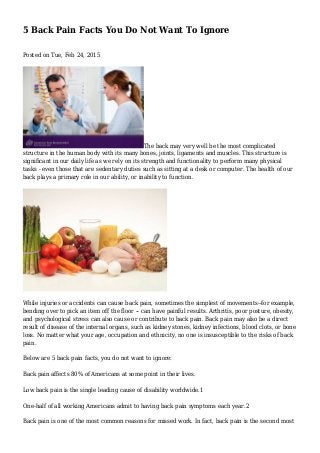
5 Back Pain Facts You Do Not Want To Ignore
- 1. 5 Back Pain Facts You Do Not Want To Ignore Posted on Tue, Feb 24, 2015 The back may very well be the most complicated structure in the human body with its many bones, joints, ligaments and muscles. This structure is significant in our daily life as we rely on its strength and functionality to perform many physical tasks - even those that are sedentary duties such as sitting at a desk or computer. The health of our back plays a primary role in our ability, or inability to function. While injuries or accidents can cause back pain, sometimes the simplest of movements--for example, bending over to pick an item off the floor -- can have painful results. Arthritis, poor posture, obesity, and psychological stress can also cause or contribute to back pain. Back pain may also be a direct result of disease of the internal organs, such as kidney stones, kidney infections, blood clots, or bone loss. No matter what your age, occupation and ethnicity, no one is insusceptible to the risks of back pain. Below are 5 back pain facts, you do not want to ignore: Back pain affects 80% of Americans at some point in their lives. Low back pain is the single leading cause of disability worldwide.1 One-half of all working Americans admit to having back pain symptoms each year.2 Back pain is one of the most common reasons for missed work. In fact, back pain is the second most
- 2. common reason for visits to the doctor's office, outnumbered only by upper-respiratory infections. Most cases of back pain are mechanical or non-organic--meaning they are not caused by serious conditions, such as inflammatory arthritis, infection, fracture or cancer. Investigating and understanding your symptoms may be your first step to combatting the causes of back pain. Acute and chronic pain can take on a variety of characteristics including constant, intermittent or only occur with certain activities. Pain may stay in one spot or radiate to other areas as well as may be dull, sharp or burning. While very common, symptoms of back pain vary greatly. There are many resources available to help you have a better understanding of the potential causes of your pain. In addition to the many resources available, back pain specialists provide the best source of knowledge and guidance in regard to prevention, diagnosis and treatment planning to help individuals get back to living the lifestyle they enjoy most. There are many minimally invasive treatments available for back pain sufferers offering fast recovery time with little pain and no missed work days. While treatment options for back pain continue to advance, learning ways to prevent back pain is the best way to avoid conditions that can put limitations on your day-to-day activities. Here are a few great tips to consider: Maintain a healthy diet and weight. Remain active--under the supervision of your doctor. Warm up or stretch before exercising or other physical activities. Maintain proper posture. Wear comfortable, low-heeled shoes. Practice proper lifting techniques by lifting with your knees, keep the object close to your body, and do not twist when lifting. Quit smoking. Smoking impairs blood flow, resulting in oxygen and nutrient deprivation to spinal tissues. Understanding prevention tips, identifying symptoms, and working alongside a back pain specialist to obtain an accurate diagnosis and effective treatment plan is the first step in effective pain relief. What steps are you taking to understand your risk and prevent back injury and pain? References: 1. Global Burdon of Disease 2010 2. Vallfors B. Acute, Subacute and Chronic Low Back Pain: Clinical Symptoms, Absenteeism and Working Environment. Scan J Rehab Med Suppl 1985; 11: 1-98.